
History of the Black Pete debate – a reading list
For years now, the debate around Black Pete in the Netherlands has been one of the most controversial topics in the public sphere. And the intensity of the debate hasn’t waned much over time. According to some, Black Pete is just a character in a harmless tradition aimed at children, while others speak of a harmful stereotype exacerbating institutional racism. In the meantime, many authors, historians and polemicists have weighed in on the debate, attempting to put arguments in context, enrich the debate from an historical perspective or trying to persuade the general public to join their side. Leiden University Libraries (UBL) holds a considerable collection from either of these categories, making it a particularly useful resource to better understand the history of Black Pete and to analyse and reconstruct the debate around the character.
The UBL has gathered a substantial and diverse collection around the character of Black Pete and the debate around his character. The list below is, therefore, only an incomplete selection from the hundreds of books the UBL owns on this topic. All books below are available for loan by following the link under the title or by searching our catalogue.
From the UBL collections
Who is Black Pete? Has his appearance changed over the last couple of years? And how have Sinterklaas celebrations in the Netherlands changed over the centuries? These books, mostly written by academics, provide the reader with a clearer view on the identity, development and cultural significance of Black Pete as a character in the history of the Netherlands. By taking a step back and examining the subject from an academic perspective, it is possible to assess the arguments for and against Black Pete in a substantiated manner.
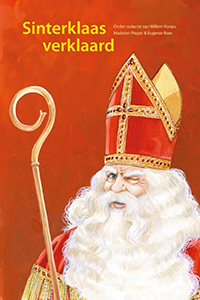
Willem Koops, Madelon Pieper, Eugenie Boer, Sinterklaas verklaard.
2009
In this small collection of essays, Saint Nicolas and Sinterklaas celebrations are discussed from a number of different perspectives: Art history, educational theory, literature studies and study of folklore. In this way, the book shows how Sinterklaas celebrations have changed over the past centuries, how Saint Nicolas fulfilled an ever-changing role in the story (from a stern and severe educator to very empathetic) and how songs about the character have changed.
The book also includes a contribution from John Helsloot, researcher at the Meertens Institute, about the history of the debate around Black Pete. Helsloot, who did extensive research on Sinterklaas celebrations and (the debate around) Black Pete, shows how the debate has evolved since the 1960s, and, among other things, endeavors to explain why this topic is debated with such passion.
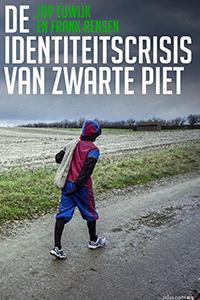
Jop Euwijk, Frank Rensen, De identiteitscrisis van Zwarte Piet.
2017
Euwijk and Rensen, creators of the exhibition “Zwarte Piet in de media” [Black Pete in the media] (Persmuseum 2016), discuss the origins of Black Pete in a clear and concise way by mapping his development as a character and the debate around him over time, going back to the 1930s.
The book shows that Pete doesn’t have a singular origin and that his appearance has changed significantly since the very beginning. Euwijk and Rensen show that even in the 1930s, Black Pete was criticized, but that this criticism only gained real traction in 2011. Why only then, and why has the debate been so strained since then?
The book doesn’t provide easy answers but does provide a great overview of the development of Black Pete and the debate around his character.
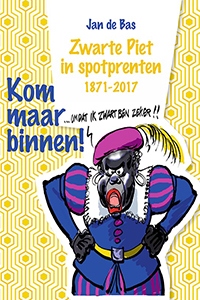
Jan de Bas, Kom maar binnen! - Zwarte Piet in spotprenten 1871-2017.
2017
Cultural historian Jan de Bas had already written some studies on the history of Sinterklaas before this one, like Een mijter zonder kruis : Sint-Nicolaas in de protestantse pers 1945-2000 [A miter without a cross: St. Nicolas in the protestant press 1945-2000]. In Kom maar binnen, De Bas analyses caricatures from Dutch newspapers and magazines to answer the question: How was Black Pete depicted and how did this depiction change over time? To do so, he has analysed over 1200 cartoons. This analysis, in the context of an increasing debate around the role and future of Black Pete, shows that the changes in Pete’s appearance in cartoons are an integral part of the debate around Pete himself and the stereotyping of black people.
Mapping the debate
The UBL doesn’t just collect academic analyses of Black Pete, but also books that take a clear position in the current debate. These books stirred a lot of controversy and were received with mixed reviews. They are, however, very important for future research and can provide the reader with new perspectives on the arguments made on both sides of the debate, for and against the preservation of Black Pete as a character in whatever form.
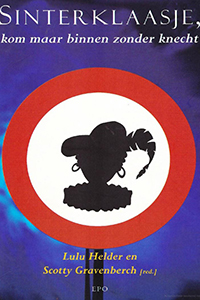
Lulu Helder, Scotty Gravenberch, Sinterklaasje, kom maar binnen zonder knecht.
1998
In contrast to the attempts to objectively and academically analyze the character, the UBL also holds books that do take clear position against Black Pete. In 1988, Rahina Hassankhan wrote ‘Al is hij zo zwart als roet…’, as commissioned by the ‘National Society for Surinamese’. Ten years earlier, anthropologist Lulu Helder and novelist Scotty Gravenbergh, published the collection of essays Sinterklaasje, kom maar binnen zonder knecht. This book is outspokenly socially engaged, as Lulu Helder was co-founder of the 1994 action group Zwarte Piet = Zwart Verdriet [Black Pete = Black Grief]. The collection, however, is not just polemic in nature. It contains contributions from academics, artists, and authors, but also contains personal stories of people that were bullied because of Black Pete.
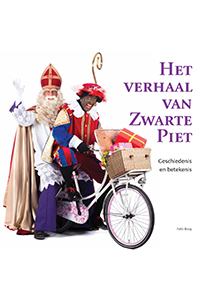
Frits Booy, Het verhaal van Zwarte Piet: geschiedenis en betekenis.
2014
The UBL also holds works in favour of maintaining Black Pete as character. In Het verhaal van Zwarte Piet : geschiedenis en betekenis [The story of Black Pete: history and meaning], Frits Booy makes a fervent argument for Pete, although he prefers ‘Soot Pete’, a deracialized version of the character. As a board member of the Nationaal Sint Nicolaas Comité [National Saint Nicolas Committee], Booy promotes the preservation of Sinterklaas celebrations, but also analyses their history. He investigates the origins and development of Black Pete over time, ending with a plea against simply removing Black Pete from Sinterklaas celebrations altogether.
Which books do Leiden staff members recommend?
The library asked two Leiden University staff members which books they would recommend to better understand the debate around Black Pete. Maartje Janse and Karwan Fatah-Black, both lecturers at the Leiden University institute for history, suggest approaching the debate around Black Pete from a different perspective, by learning more about perceptions of black people in the Netherlands. In that light, they recommend the following books:
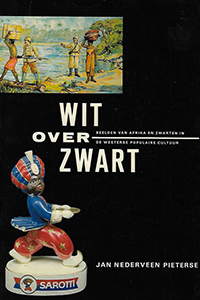
Jan Nederveen Pieterse, Wit over zwart: beelden van Afrika en zwarten in de westerse populaire cultuur.
1990
Based on the exhibition Wit over Zwart [White over/about Black] in the Tropenmuseum (1989), sociologist Jan Nederveen Pieterse wrote a book about the ways in which black people were historically depicted in the West. For this purpose, he uses adverts, product packaging imagery, cartoons and other images. Black Pete only occupies a small section of this book, which features many other derisive depictions, but precisely because of that, Nederveen Pieterse shows that imaging of Black Pete doesn’t exist in a vacuum, but is part of a long, international tradition.
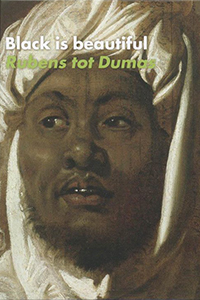
Elmer Kolfin, Vincent Boele, Michèle Hendricks, Black is beautiful: Rubens tot Dumas.
2008
In 2008, another exhibition was made about the imaging of black people, this time in the Nieuwe Kerk in Amsterdam. Again, images prominently featured, but while the Tropenmuseum exhibited popular images from a variety of different countries, Black Is Beautiful consisted mainly of paintings and other art from the Netherlands. The focus of the exhibition were black beauty ideals in Dutch art. The exhibition catalogue offers the reader an overview of exhibited works and art-historical analyses.
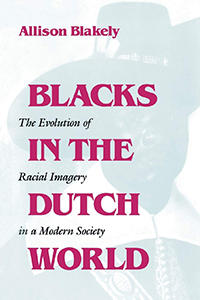
Allison Blakely, Blacks in the Dutch world: the evolution of racial imagery in a modern society.
1993
Blakely, too, takes images as a starting point for her study of Dutch image culture around black people throughout history. According to Blakely, Dutch attitudes toward black people were predominantly positive, up until the seventeenth century, when more and more stereotypical images were employed to justify and defend colonialism and the slave trade. Different from the other two book above, Black Pete is the starting point of Blakely’s argument and analysis. In his point of view, Black Pete is symbolic for the ambiguous, long held attitude Dutch people had toward black people: Black Pete is both loved and feared at the same time. Based on extensive research into images, (children’s) literature and religious traditions, Blakely expounds on the development of Dutch attitudes regarding black people over the centuries.
Do your own research
UBL provides access to several databases, giving you the opportunity to do your own research into the history of Sinterklaas, Black Pete and the debate about both.
Newspaper database Delpher, created by the National Library, provides access to millions of digitized newspaper pages from a period between 1610 and 1995. Almost all these newspaper articles have been made searchable through Optical Character Recognition (OCR), making very detailed searches possible.
Nexis Uni provides access to articles from the period after 1995, enabling researchers to map and analyse the current debate. Users need a ULCN-account to access Nexis Uni.
Leiden Research
Leiden University students have also been doing research into the history of Sinterklaas and Black Pete. In the Leiden Repository, several BA and MA theses can be found on this theme.
An example of research that has been done by Leiden University researchers and students about perception of Black Pete is the research paper by Judi Mesman, Sofie Janssen and Lenny van Rosmalen. This paper is based on psychological research and asks questions about how young children see Black Pete and describe and characterize him.
Contact your faculty liaison
Is a book missing on this list, or would you like UBL to purchase a book about Black Pete that is not yet available in our collections? Contact our faculty liaisons.
